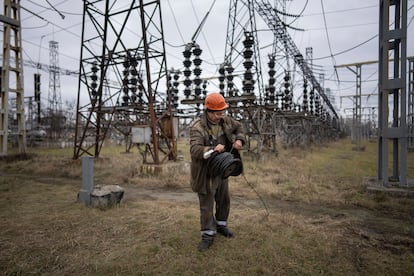Ukraine to renew electricity exports after Russian campaign to destroy power grid fails
Months of energy restrictions have come to an end and Kyiv has restored all destroyed infrastructure as Moscow’s attacks falter due to missile shortages


The Russian bombing campaign to destroy the Ukrainian energy grid has failed in its objective and the government of Volodymyr Zelenskiy on Friday signed an authorization to restart the export of electricity. Repair work on attacked power plants and substations, in addition to a shortfall in the supply of Moscow’s cruise missiles to continue pounding essential infrastructure, has restored normality to the streets of the country, where the noise of electric generators has largely fallen silent.
Power outages and the use of generators in commercial establishments have been progressively reducing since mid-February. Gone are the harsh winter months when daily blackouts and a lack of heating and hot water due to supply interruptions affected large areas of the country as Russia launched a sustained attempt to knock out power stations across Ukraine. The Ukrainian Ministry of Energy confirmed on Friday that service has now been completely restored. Kyiv’s aim now is to once again tap into the economic resources provided by electricity exports to the European Union and Moldova.
“The Ukrainian energy system has been operational without restrictions for consumers for almost two months now, even with power reserves,” Energy Minister Herman Halushchenko said in a statement. “We have achieved this through the titanic efforts of our engineers and with the help of our international partners.” EU member states provided equipment and funding to help with the reconstruction of destroyed power stations.
Russia initiated a periodic bombing campaign against the Ukrainian energy network on October 10, which lasted until January. The European Commission branded the offensive as a war crime because it targeted civilian infrastructure that left millions of households without resources to combat freezing temperatures during the winter. Russian missiles and drones struck the power grid across the country during the autumn and into winter, particularly in October and November, when bombing in cities far from the front lines tripled compared to the summer. As a result, the European Union saw a further increase in refugees fleeing Ukraine, especially among vulnerable groups such as children and the elderly.
Energy exports are essential to Kyiv’s public coffers, which urgently need to increase their revenues. The country’s GDP fell by about 30% in 2022, after the Kremlin launched its full-scale invasion. The Zelenskiy administration recently announced that it will also tighten tax collection control after a period of laxity due to the effects of the war. The Pravda newspaper reported Saturday that the government is also planning a push to collect those taxes required as donations for the Armed Forces of Ukraine.
Russia’s lack of missiles
Another factor behind Ukraine’s successful restoration of its energy system is that Moscow has depleted most of its cruise missile arsenal and this has reduced the ability of Russian forces to attack infrastructure. Ukraine’s air defense capabilities have also been beefed up with the contribution of advanced anti-aircraft batteries and missile defense systems from its NATO allies.
European military experts consulted by EL PAÍS earlier this year, including French general Jerôme Pellistrandi, estimated the number of precision and long-range missiles remaining in Moscow’s arsenal at 30% of pre-war levels. Ukraine’s intelligence services claimed in March that the number of such missiles remaining at the Kremlin’s disposal was already close to zero. “The truth is that the length of time between bombardments has increased and fewer missiles are being used in attacks because they have a shortage and are not able to produce the numbers required,” says Hanna Shelest, director of the defense studies program at the Ukrainian Prism analysis center.
Russian Defense Minister Sergei Shoigu announced in March that he had ordered the Russian arms conglomerate KTRV to double its production of long-range guided missiles, especially the Kh-101 cruise missile, which is launched from bombers. However, achieving this goal is a complex mission due to international sanctions preventing Russian imports of sensitive material, which has diminished Moscow’s capacity to produce weapons.
In the absence of sufficient cruise missiles to sustain attacks, Russian forces are increasingly reliant on Iranian-made Shahed drone bombs, which are far easier for air defense systems to shoot down. Yuri Ihnat, a spokesman for the Ukrainian Air Force, told EL PAÍS in February that Russia’s strategy has now shifted to using Shahed drones not to hit targets, but to identify the position of anti-aircraft defenses.
Despite the recovery of its power grid Ukraine has lost important assets, especially the Zaporizhzhia Nuclear Power Station in southeastern Ukraine, the largest in Europe and which produced 50% of the country’s nuclear electricity before the war. The plant was occupied by Russian forces in the early stages of the invasion. The Times reported Saturday that an aborted attempt was launched by Ukrainian forces last October to liberate Enerhodar, the municipality where the power station is located. According to The Times, the operation involved 600 soldiers attempting to land on the Russian-held eastern bank of the Dnipro River in 30 speedboats.
Another power plant and a key dam for Ukrainian energy production are located in Nova Kakhovka, also on the eastern bank of the Dnipro. These infrastructures are also occupied by Russian forces and in recent months defensive positions around them have been reinforced to repel a potential Ukrainian counteroffensive.
Sign up for our weekly newsletter to get more English-language news coverage from EL PAÍS USA Edition
Tu suscripción se está usando en otro dispositivo
¿Quieres añadir otro usuario a tu suscripción?
Si continúas leyendo en este dispositivo, no se podrá leer en el otro.
FlechaTu suscripción se está usando en otro dispositivo y solo puedes acceder a EL PAÍS desde un dispositivo a la vez.
Si quieres compartir tu cuenta, cambia tu suscripción a la modalidad Premium, así podrás añadir otro usuario. Cada uno accederá con su propia cuenta de email, lo que os permitirá personalizar vuestra experiencia en EL PAÍS.
¿Tienes una suscripción de empresa? Accede aquí para contratar más cuentas.
En el caso de no saber quién está usando tu cuenta, te recomendamos cambiar tu contraseña aquí.
Si decides continuar compartiendo tu cuenta, este mensaje se mostrará en tu dispositivo y en el de la otra persona que está usando tu cuenta de forma indefinida, afectando a tu experiencia de lectura. Puedes consultar aquí los términos y condiciones de la suscripción digital.
More information
Archived In
Últimas noticias
Most viewed
- Sinaloa Cartel war is taking its toll on Los Chapitos
- Oona Chaplin: ‘I told James Cameron that I was living in a treehouse and starting a permaculture project with a friend’
- Reinhard Genzel, Nobel laureate in physics: ‘One-minute videos will never give you the truth’
- Why the price of coffee has skyrocketed: from Brazilian plantations to specialty coffee houses
- Silver prices are going crazy: This is what’s fueling the rally










































